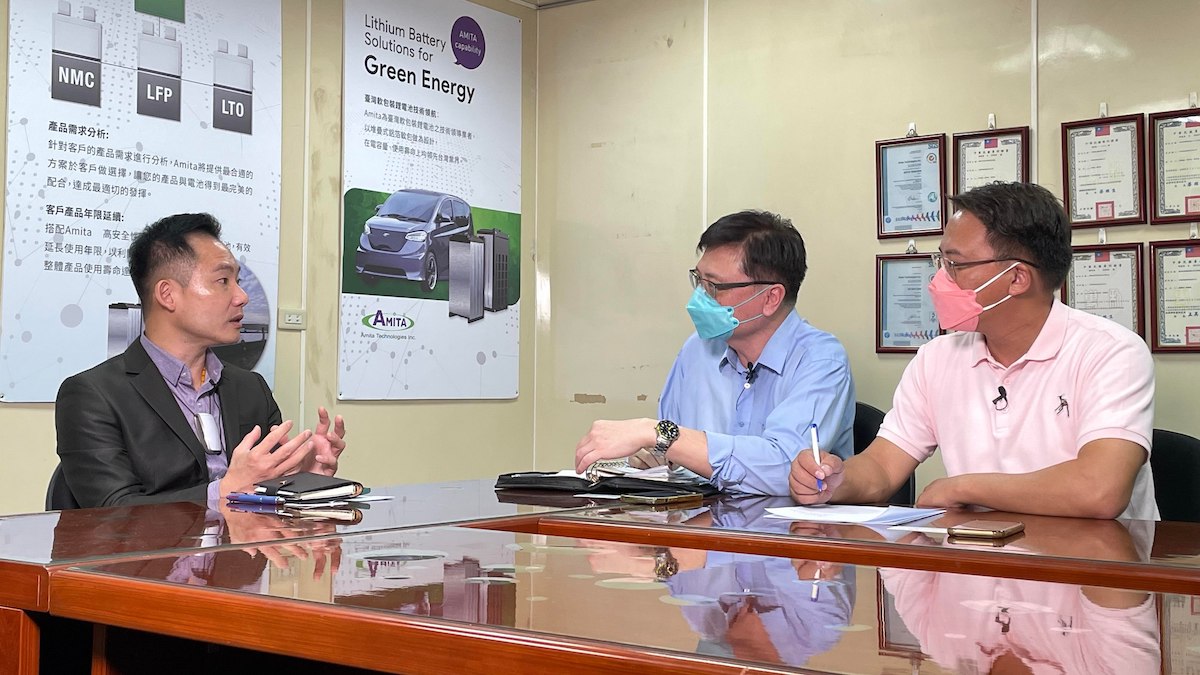Taiwan actually has proven strengths in the advancement of power battery technology, but the crux lies in the absence of an outlet for business expansion, hence the limit on long-term investment in R&D to some extent. However, Amita Technologies, located in Guishan, Taoyuan, leveraged its solid foundation of battery technology to draw EA of Thailand for cooperation that kicked off in 2018. EA went further two years ago to take over Amita and start joint operation and expansion in Taiwan and Thailand. In the afternoon of November 15, the Auto Future editorial team had a talk with Chris Lee, the general manager, about Amita's future technology applications and business-oriented development plans.
 Chris Lee (Left) , the general manager of Amita Technologies, had an interview with Jeff Lee (Middle) and Seven Tseng (Right), editors of Auto Future.
Chris Lee (Left) , the general manager of Amita Technologies, had an interview with Jeff Lee (Middle) and Seven Tseng (Right), editors of Auto Future.
Founded in 2000, Amita received a license a few years ago from ITRI to use the STOBA (Self-Terminated Oligomers with Hyper-Branched Architecture) battery material for mass production of lithium-ion batteries. STOBA is a nanoscale high polymer whose tree structure forms a protective film with the surrounding molecules when the operating temperature of the battery is excessively high (e.g., when the vehicle is running at high speed, or when it is at fast-charging) to stop the lithium ions from reacting chemically with the electrolytes so that the temperature does not continue to rise. The benefits to the battery include increased safety, longer lifespan, and improved performance of fast charging and discharging, so this technology, also known as "lithium polymer battery", has gained the favor of EA. In addition, ITRI continues to cooperate with Amita on the technology of NAEPE
(Networked Amide Epoxy Polymer Electrolyte) resin solid-state batteries. The energy density of the prototype reaches 260 wh/kg, a level of technology that even the world's top ternary lithium battery can hardly rival, and more importantly, high safety and long lifespan are still guaranteed. More importantly for business development, these two unique technologies can be applied to three types of lithium-ion batteries: NMC, LFP, and LTO, giving an edge to EA and Amita in the competitive market. The battery plant built in Thailand at the end of last year used precisely STOBA to commence trial mass production, and official mass production will start by the end of this year. The Company will also take advantage of the incentive program just announced by the Thai government and fully position itself in the Southeast Asian market for applications such as electric buses, electric boats, electric trucks, and even electric locomotives. Speaking of future operational planning for the battery plant in Thailand, Chris particularly pointed out that the current 1 GWh annual capacity will be expanded to 2 GWh by the end of next year and to 4 GWh by 2024. Of course, most of the capacity will be for the above applications identified by EA. Considering the prevailing trend that many ASEAN countries will put an end to importing gasoline vehicles and go all out for EVs after 2023, EA will mull over the feasibility of building a plant that has an annual capacity of up to 50 GWh to meet the demand of the passenger EV industry for batteries in different countries. At present, EA still focuses business operations on mass transit vehicles (buses, boats, locomotives, etc.). In the future, EA will give priority to smaller vehicles in the passenger vehicle business to be in line with the Company's mission of energy saving and carbon reduction. As for the development in Taiwan, Amita focuses on technology R&D. The Guishan battery plant will adopt fully automated production just like the Thai plant and use the battery production technology for electric buses, trucks, and motorcycles to bring the value of Amita's products to the next level.
At the end of the interview, Chris emphasized that the technological evolution of power batteries would not be about a variety of formulae, but about safety and service life. Only when the key technical indicators earn the trust of consumers will the application of EVs begin to see true popularization. Having gained experience in mass production from ITRI technology transfer, Amita will be able to help EA play a vital role in the development of the EV industry and energy storage facilities in Southeast Asia in the coming years.